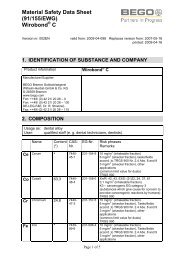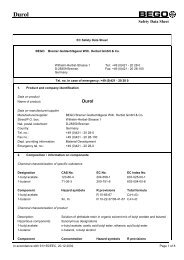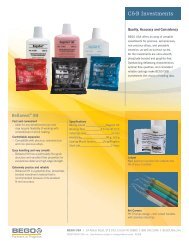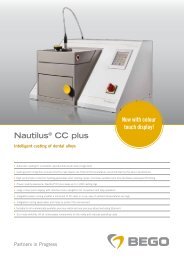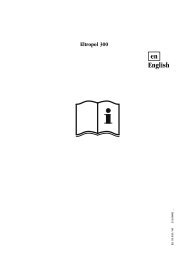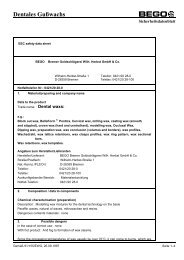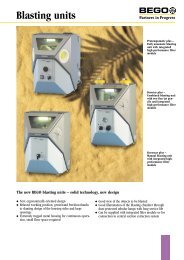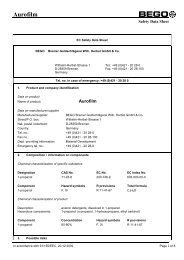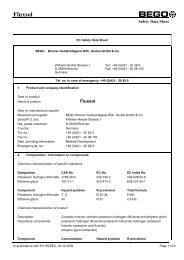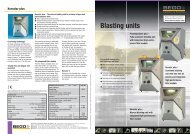Isocera MSDS - Bego USA
Isocera MSDS - Bego USA
Isocera MSDS - Bego USA
You also want an ePaper? Increase the reach of your titles
YUMPU automatically turns print PDFs into web optimized ePapers that Google loves.
<strong>Isocera</strong><br />
Safety Data Sheet<br />
EC Safety Data Sheet<br />
BEGO<br />
Bremer Goldschlägerei Wilh. Herbst GmbH & Co.<br />
1. Product and company identification<br />
Wilhelm-Herbst-Strasse 1 Tel.: +49 (0)421 - 20 28-0<br />
D-28359 Bremen Fax: +49 (0)421 - 20 28-100<br />
Germany<br />
Tel. no. in case of emergency: +49 (0)421 - 20 28 0<br />
Data on product<br />
Name of product:<br />
<strong>Isocera</strong><br />
Data on manufacturer/supplier<br />
Manufacturer/supplier:<br />
BEGO Bremer Goldschlägerei Wilh. Herbst GmbH & Co.<br />
Street/P.O. box: Wilhelm-Herbst-Strasse 1<br />
Nat. postal code/town:<br />
D-28359 Bremen<br />
Country:<br />
Germany<br />
Tel. no.: +49 (0)421 - 20 28-0<br />
Fax no.: +49 (0)421 - 20 28-100<br />
Dept. providing information: Material Development<br />
Emergency tel. no.: +49 (0)421 - 20 28-0<br />
2. Composition / information on components<br />
Chemical characterization of specific substance<br />
Designation CAS No. EC No. EC Index No.<br />
1-propanol 71-23-8 200-746-9 603-003-00-0<br />
Component Hazard symbols R provisions Total formula<br />
1-propanol F, Xi R 11-41-67 C 3 H 8 O<br />
Chemical characterization of product<br />
Description:<br />
Hazardous components:<br />
anionic detergents, dissolved in 1-propanol<br />
1-propanol (n-propanol, 1-hydroxypropane, ethyl carbinol)<br />
Component Concentration Hazard symbols R provisions<br />
1-propanol 30-50% Xi R 10-41-67<br />
3. Possible risks<br />
In accordance with 91/155/EEC, 20.12.2002 Page 1 of 8
<strong>Isocera</strong><br />
Designation of hazards<br />
Hazard identification:<br />
Xi<br />
flammable<br />
irritating<br />
Special indications of risk for people and environment<br />
Flammable. Risk of serious eye damage. Vapours may cause drowsiness and a dazed state.<br />
Specific risks<br />
Possible harmful impact on people and possible symptoms:<br />
Processing vapours may irritate the respiratory tracts, skin and eyes. Skin contact and inhalation of<br />
aerosols/vapours of the preparation should be avoided. During work wear suitable protective clothing, safety<br />
gloves and safety goggles / face screen. Easily inflammable or explosive vapour-air mixtures may form due to<br />
evaporation during use.<br />
4. First aid measures<br />
General instructions<br />
Take the person out of the danger zone while protecting oneself and lay him/her down. Remove clothing that<br />
is dirty, soaked or contaminated with the product immediately. Place injured person in a relaxed position and<br />
protect against hypothermia. In the event of contact with the eyes, rinse thoroughly with water and provide for<br />
medical treatment. In the case of an accident or indisposition, call in a physician at once (if possible, show<br />
this label and inform about measures taken). A medical expertise is necessary even if intoxication is merely<br />
suspected. Symptoms of intoxication may not appear until hours later; therefore, medical observation<br />
necessary for at least 48 hours.<br />
After inhalation<br />
In the event of inhalation, take the person out of the danger zone and remove to fresh air. In the case of<br />
shortness of breath, have person inhale oxygen. If person is unconscious and breathing, place in a lateral<br />
recovery position. In case of cessation of breathing: carry out mouth-to-nose respiration or, if not possible,<br />
then mouth-to-mouth respiration. Keep respiratory tracts clear. In the event of cardiac arrest (lack of<br />
heartbeat, lack of pulse), carry out heart-lung resuscitation immediately. Ensuring vital functions (beating<br />
heart and independent breathing) has priority over all other measures. If consciousness is maintained, have<br />
person inhale deeply Dexamethason-21-isonicotinate (e.g. Auxiloson dosing aerosol spray) as far as<br />
possible: 4 sprays at the beginning, after that two additional sprays every five minutes until the first pack is<br />
empty. After that one spray every hour.<br />
After skin contact<br />
Remove wet clothing while protecting oneself. Rinse parts of the skin affected under running water for 10<br />
minutes. If available, it is better to apply polyethylene glycol (e.g. Lutrol, PEG 400) and allow to react for<br />
several minutes, then rinse off with water. Provide for medical treatment. Do not use alcohol, benzene or<br />
other solvents under any circumstances. In the case of large-scale or long-lasting skin contamination, provide<br />
for medical treatment.<br />
After eye contact<br />
In the event of contact with the eyes, rinse eyes under running water with eyelids open for at least 15<br />
minutes. Rinse from the inner to the outer corner of the eyes. Put on loose bandage. Consult a physician at<br />
once.<br />
After swallowing<br />
In accordance with 91/155/CEE, 20.12.2002 Page 2 of 8
<strong>Isocera</strong><br />
Immediately have person drink plenty of water (at least 0.5 l) in small sips (dilution effect) while conscious.<br />
Give person activated carbon for medical use (3 tablespoons of activated carbon dispersed in a glass of<br />
water). Rinse mouth thoroughly with water, spit out liquid. Do not induce vomiting. If product is swallowed with<br />
subsequent vomiting, aspiration into the lungs may result, which can lead to chemical pneumonia or<br />
suffocation. In the case of spontaneous vomiting hold or place person’s head in a low position to keep the<br />
respiratory tracts clear. Never administer cooking oil, castor oil, milk or alcohol. Provide for medical<br />
treatment.<br />
Information for the physician<br />
Symptoms of acute intoxication:<br />
Vapours of the substance cause irritation on the mucous membranes of the eyes and of the respiratory tract.<br />
Reddening, flow of tears, blepharism, corneal clouding and/or salivation, burning sensation in the mouth,<br />
excruciating urge to cough, nausea and retrosternal pain are the characteristic symptoms. In the case of<br />
mucous membrane contact with the liquid contaminant, irritations of varying intensity occur. The systemic<br />
effect after inhalation/ingestion begins with dizziness, headache, nausea, vomiting. This prodromal stage<br />
leads, via confusion and intoxication, to paralysis of the central nervous system, either rapidly or after a delay<br />
depending on the dose, with reduced reflex, loss of muscle tone, clouding of consciousness, loss of vital<br />
regulation mechanisms, deep narcosis and risk of central respiratory paralysis.<br />
Instructions for first aid<br />
If necessary, rinse eyes affected, provide for specialized further medical treatment. Treat skin that has been<br />
contaminated intensively or for a long time using polyethylene glycol 400 and after allowing it to take effect for<br />
10 minutes, rinse with water. In the case of intoxication through inhalation while the person is still conscious,<br />
administer glucocorticoid parenterally and as an aerosol at once. In the narcotic to asphyxial stage of<br />
intoxication absolute priority must be given to securing the circulatory and breathing function, followed by<br />
oxygen administration. For extremely severe forms consider application of a centrally effective alphasympathomimetic<br />
drug (e.g. Dopamin) or a central analeptic agent (Bemegrid / Pentetrazol /<br />
Methamphetamin). After oral ingestion while (still) conscious induce vomiting and subsequently instil<br />
activated carbon for a prolonged period. As of prenarcotic stage, wash out stomach only through<br />
endotracheal intubation, followed again by administration of activated carbon and laxative. In every case<br />
further in-patient treatment; application of haemodialysis or other intensive toxin elimination method may be<br />
necessary. Monitoring of liver and kidney parameters, acid-base balance as well as circulatory, pulmonary<br />
and central nervous system function is urgently indicated.<br />
5. Fire-fighting measures<br />
Suitable extinguishing agents<br />
CO 2 , fire extinguishing powder or foam, or water spray jet. Adapt fire-fighting measures to surroundings.<br />
Suppress vapours with spray jet. Fight larger fire with water spray jet or alcohol-resistant foam.<br />
Extinguishing agents unsuitable for safety reasons<br />
Water in full jet.<br />
Special risk due to substance or the product itself, its products of combustion or resulting gases, further<br />
information<br />
The product is combustible. Vapours have a benumbing effect, are heavier than air and spread on the<br />
ground. Ignition possible over large distance. Hazardous conflagration gases or vapours may form due to<br />
ambient fire. Cool nearby drums and containers immediately with water spray. In the event of fire, carbon<br />
monoxide, among other things, may be released.<br />
In accordance with 91/155/CEE, 20.12.2002 Page 3 of 8
<strong>Isocera</strong><br />
Special protective equipment for fire fighting<br />
Use suitable breathing apparatus that is independent of ambient air. Use protective clothing for fire-fighting so<br />
as to avoid skin and eye contact. Stay in the danger zone only with suitable impervious chemical protection<br />
suit.<br />
Other instructions<br />
Increase in pressure, danger of bursting and explosion when heated. Fire classification B (liquid or<br />
deliquescent substances). If possible, take containers out of danger zone. Eliminate sources of ignition.<br />
Watch out for flashback. Remain on side towards the wind. Only use explosion-proof and non-sparking<br />
equipment. Use solvent-resistant auxiliary equipment. Cool endangered containers with water spray jet.<br />
Suppress vapours with water spray jet. Avoid penetration of fire-fighting water in surface waters or<br />
groundwater.<br />
6. Measures in the event of unintentional release<br />
Personal precautionary measures<br />
Clear danger zone. Warn those concerned in surrounding area. To eliminate the danger, the danger zone<br />
must only be entered while taking suitable protective measures (respiratory equipment, safety goggles, safety<br />
boots, safety gloves). Keep unprotected persons away. Increased risk of slipping due to leaking or spilt<br />
product. Keep away open flames, heat sources and other sources of ignition. Formation of explosive mixtures<br />
with air possible. Ensure very good ventilation. Avoid contact with substance. Do not pick up with unprotected<br />
hands. Avoid contact with skin, eyes and clothing. Do not inhale vapours/aerosols. Wear protective clothing in<br />
accordance with section 8 of this safety data sheet.<br />
Environmental protection measures<br />
Do not allow to enter subsoil/ground. Do not allow to enter sewer system / surface waters / groundwater.<br />
Hazard to drinking water only possible in case of penetration of very large amounts in subsoil and<br />
waterbodies. Notify authorities.<br />
Cleaning/collection procedure<br />
Wear rubber gloves. Use non-sparking tools. Collect with liquid-binding material (e.g. activated coal, clay<br />
mineral, diatomaceous earth, universal binder). Put leaky receptacles, residues and contaminated material in<br />
identified and sealable containers. Dilute small quantities with plenty of water and wash away. Clean wet<br />
surfaces immediately with plenty of water. If necessary, clean again and air thoroughly. Disposal as waste in<br />
accordance with section 13 of this safety data sheet.<br />
7. Handling and storage<br />
Handling – instructions for safe handling<br />
Keep containers tightly sealed. Only use in well ventilated areas. Avoid contact with eyes and skin. Do not<br />
inhale gas/smoke/vapour/aerosol.<br />
Handling – instructions regarding fire and explosion protection<br />
The product is combustible. Vapour-air mixtures are explosive. Area with risk of explosion. Keep away from<br />
ignition sources (e.g. electrical equipment, open flames, heat sources and sparks). Extinguish all open<br />
flames, eliminate sources of ignition, avoid formation of sparks. Do not smoke. Avoid static charging and<br />
discharging: do not spray product, do not transfuse in free fall. Do not discharge in drains (risk of explosion).<br />
Prevent gases or vapours from entering other rooms that contain sources of ignition. Remote ignition through<br />
creeping vapours possible.<br />
In accordance with 91/155/CEE, 20.12.2002 Page 4 of 8
<strong>Isocera</strong><br />
Storage – storeroom and container requirements<br />
Keep under lock and key. Keep containers tightly sealed and store in a cool, dry and well ventilated place. Do<br />
not store together with very toxic, toxic, fire-promoting and spontaneously combustible substances as well as<br />
with easily inflammable solid substances. Keep away from direct sunlight and sources of heat and ignition. Do<br />
not smoke in storage area. Suitable material for containers/equipment: material, solvent-resistant. The floor<br />
should be tight, have no joints and be non-absorbent. VCI storage class: LGK 3 A (according to VCI concept),<br />
Inflammable liquid substances.<br />
8. Exposure control and personal protective equipment<br />
Components with workplace-related or biological limit values that must be monitored<br />
Not applicable.<br />
Limitation and monitoring of exposure<br />
See section 7. No measures beyond that are necessary.<br />
Personal protective equipment<br />
Respiratory protection<br />
Not necessary as long as product is used properly. Respiratory protection is necessary if vapours/aerosols<br />
occur and if there is increased concentration in the air.<br />
Type of mask: full mask (DIN EN 136) or half-mask (DIN EN 140).<br />
Respiratory protection filter: filter class A (organic gases), identification colour: brown.<br />
Hand protection<br />
Use solvent-resistant safety gloves made of nitrile rubber/nitrile latex (NBR, 0.35 mm), butyl rubber (butyl,<br />
0.5 mm) or fluorocaoutchouc (0.4 mm) with at least 10 cm long sleeve. Check for leaks before using. Ensure<br />
skin protection. Preclean gloves while still worn on hands before removing them, then keep them in a well<br />
ventilated place. In case of continuous contact, do not wear gloves of polychloroprene (CR, 0.5 mm) for<br />
longer than 2 hours. Glove material of natural caoutchouc/natural latex (NR) and polyvinyl chloride (PVC) are<br />
not suitable. Fabric or leather gloves are entirely unsuitable.<br />
Eye protection<br />
Tightly sealing safety goggles with side protection and lenses made of safety glass. If contact of the eyes with<br />
liquids is possible, safety goggles with face screen are necessary. If eye-damaging vapours or aerosols may<br />
occur, the eyes are best protected with a full mask.<br />
Body protection<br />
Wear flame-retardant, antistatic protective work clothing. Protective aids for the body are to be selected<br />
depending on the concentration and amount of hazardous substance and according to the specific<br />
workplace. Pay attention to chemical resistance of the protective aids (suppliers).<br />
General safety and hygienic measures<br />
Avoid contact with eyes, skin and clothing. Do not inhale gases/vapours/aerosols. Remove contaminated<br />
and/or soaked clothing at once. Keep away from food. Do not eat, drink, smoke or take snuff during work.<br />
Wash hands before breaks and at the end of work. Preventive skin protection by means of protective skin<br />
ointment. Further suitable skin care measures according to code of practice “Skin protection” of the<br />
employer’s liability insurance association (e.g. BG Chemie [employer’s liability insurance association for<br />
chemical industry] No. M 042). Minimum standards for protective measures when handling working<br />
In accordance with 91/155/CEE, 20.12.2002 Page 5 of 8
<strong>Isocera</strong><br />
substances are listed in TRGS 500 (Technical Rules for Hazardous Substances).<br />
9. Physical and chemical properties<br />
Appearance<br />
State:<br />
Colour:<br />
Odour:<br />
liquid<br />
colourless<br />
aniseed-like<br />
Important data on health and environmental protection and on safety<br />
Product:<br />
pH value:<br />
6-8 (1% aqueous solution)<br />
Flash point: 22°C<br />
Boiling point:<br />
100°C (101.3 kPa)<br />
Vapour pressure:<br />
< 1.33 hPa (20°C)<br />
Density.<br />
approx. 1 g/cm 3 (20°C)<br />
Aqueous solubility:<br />
completely mixable (20°C)<br />
1-propanol:<br />
pH value:<br />
neutral<br />
Flash point: 15°C<br />
Explosion limits:<br />
formation of explosive vapour-air mixtures possible<br />
- lower 2.1% by vol. (50 g/m 3 )<br />
- upper 17.5% by vol. (440 g/m 3 )<br />
Vapour pressure:<br />
19.3 hPa (20°C), 36 hPa (30°C), 112 hPa (50°C)<br />
Relative vapour density: 2.08<br />
Vapour saturation:<br />
48 g/m 3 (20°C), 86 g/m 3 (20°C), 251 g/m 3 (50°C)<br />
Density.<br />
0.8035 g/cm 3 (20°C)<br />
Dynamic viscosity:<br />
2.75 mPas (20°C)<br />
Melting temperature:<br />
-126.2°C<br />
Boiling point:<br />
97.2°C (101.3 kPa)<br />
Inflammation point: 412°C<br />
Aqueous solubility:<br />
completely mixable (20°C)<br />
10. Stability and reactivity<br />
Conditions to be avoided<br />
No hazardous reactions given proper use and proper storage and handling. The product is stable. Do not<br />
heat. 1-propanol decomposes into propanol and hydrogen in heat at the Cu contact at 230°C, into propylene<br />
and water in connection with aluminium oxide at 250-260°C. At 1150°C hydrogen, ethane, ethylene, ethine,<br />
propane, formaldehyde, propanol and carbon monoxide are created in the platinum tube. 1-propanol reacts<br />
strongly with alkaline metals at room temperature with development of hydrogen. Alkaline earth metals react<br />
in heat. All reactions are less vigorous than with ethanol and methanol. Strong reaction with strong oxidation<br />
agents.<br />
Substances to be avoided<br />
Alkaline metals; alkaline earth metals; strong oxidation agents; perchloric acid; permanganates; peroxides<br />
In accordance with 91/155/CEE, 20.12.2002 Page 6 of 8
<strong>Isocera</strong><br />
Hazardous decomposition products<br />
No decomposition is known given proper use. Decomposition products in event of fire are propanol, propane,<br />
propylene, ethane, ethylene, ethine, formaldehyde, carbon monoxide and hydrogen (see section 5).<br />
Further information<br />
The product is combustible and leads to risk of inflammation and/or generation of inflammable gases or<br />
vapours with air (with propanol vapour). The compound forms an explosive mixture with air.<br />
11. Toxicological information<br />
The product has an acutely irritating effect on the mucous membranes of the eyes and the respiratory organs<br />
as well as a chronic effect on the central nervous system. Sensitizing effects are not known. As a vapour and<br />
liquid predominantly local irritating effect. Slightly narcotic effect. The toxicity of 1-propanol is somewhat<br />
higher than that of isopropanol.<br />
Acute toxicity<br />
No acute toxicity known given proper use.<br />
1-propanol<br />
LDL 0 (oral, human):<br />
LD 50 (oral, rat):<br />
LD 50 (oral, mouse):<br />
LD 50 (oral, rabbit):<br />
LD 50 (dermal, rabbit):<br />
LD 50 (inhalational, rat):<br />
5700 mg/kg<br />
1870 mg/kg<br />
6800 mg/kg<br />
2825 mg/kg<br />
4000 mg/kg<br />
9.8 mg/l / 4 h<br />
Primary irritating effect<br />
1-propanol<br />
Skin, rabbit<br />
Eye, rabbit<br />
500 mg<br />
20 mg / 24 h<br />
Specific symptoms in animal experiment<br />
1-propanol<br />
Skin irritation, rabbit:: local irritation<br />
Bacterial mutagenicity: Ames text: negative<br />
Subacute to chronic toxicity<br />
Repeated skin contact may lead to dermatitis. No sensitizing effect on people (patch test).<br />
Further toxicological information<br />
After inhalation<br />
Damage both through inhalation of (possibly warm) vapours and through unintentional swallowing may occur.<br />
Depending on amount ingested, symptoms are irritation of mucous membranes, coughing and shortness of<br />
breath, headache, dizziness, drowsiness, stupor, inebriation or unconsciousness. Liver and kidney functional<br />
disorders are rare.<br />
After skin contact<br />
Slight irritation. Has a degreasing effect on the skin. May lead to rough and chapped skin. Can be taken in<br />
through the skin (risk of skin resorption). Absorption via the skin leads to the same symptoms as after the<br />
In accordance with 91/155/CEE, 20.12.2002 Page 7 of 8
<strong>Isocera</strong><br />
inhalation of vapours.<br />
After eye contact<br />
Irritation. Risk of serious eye damage. Vapours not only cause irritation of the eyes, but also burning<br />
sensation, conjunctivitis and defects of the cornea (ulceration).<br />
After swallowing<br />
Rapid resorption. Headache, dizziness, inebriation, unconsciousness, narcosis. After ingestion of larger<br />
amounts: respiratory paralysis, coma. Swallowing leads to the same symptoms as after inhalation of vapours.<br />
After resorption<br />
Monovalent aliphatic alcohols are eliminated at different speeds, primarily through oxidative degradation.<br />
Organs affected<br />
Central nervous system, liver<br />
Further information<br />
The product must be handled with the usual care in connection with chemicals.<br />
12. Ecological information<br />
Ecotoxic effects<br />
Given proper handling and use, there is no fear of any ecological problems. Causes only little biological<br />
oxygen depletion. In diluted form degradation in biological treatment plants possible. Hazardous for drinking<br />
water if larger amounts enter the soil and/or waterbodies. Do not allow to enter waterbodies, sewer system or<br />
soil!<br />
Biological effects – data for 1-propanol<br />
Fish toxicity: Pimephales promelas LC50 = 4480 mg/l / 96 h<br />
Daphnia toxicity: Daphnia magna EC 50 = 3642 mg/l / 48 h<br />
Algae toxicity: Selenastrum capricorn. IC0 = 1150 mg/l / 48 h<br />
Bacterial toxicity: activated sludge EC50 > 1000 mg/l / 3 h<br />
Photobacterium phosph. EC50 = 17700 mg/l / 5 min (Microtox test)<br />
Protozoa toxicity: Tetrahymen pyriformis EC50 = 4168 mg/l / 48 h<br />
Further ecological information – data for 1-propanol<br />
Oxygen depletion: theor. oxygen demand: ThOD = 2.4 g/g<br />
chem. oxygen demand: COD = 2.23 g/g<br />
biol. oxygen demand: BOD5 = 73.0% of COD<br />
Biological degradability<br />
1-propanol is easily biodegradable (75% in 20 days).<br />
Behaviour in the environment<br />
Accumulation in organisms is not expected (low bioaccumulation potential).<br />
Bioaccumulation: log P OW = 0.25 (experimental)<br />
Water hazard: WGK 1<br />
13. Disposal considerations<br />
In accordance with 91/155/CEE, 20.12.2002 Page 8 of 8
<strong>Isocera</strong><br />
Product<br />
Uniform regulations on disposal of chemicals in the Member States of the EU do not exist. In Germany the<br />
requirement of recycling is stipulated by the Closed Substance Cycle and Waste Management Act. The<br />
waste producer has to differentiate between “wastes for recycling” and “wastes for disposal” and carry out<br />
waste determination according to defined rules. This determination is geared to the material characteristics<br />
and in particular to the origin of the wastes. Furthermore, additional special features regarding the<br />
implementation of disposal are regulated by the German Länder. It is recommended that contact be made<br />
with the authorities and/or waste management companies and further information be obtained on recycling or<br />
disposal.<br />
Waste regulations according to Ordinance on the List of Wastes (AVV)<br />
Due to the hazardous components, the wastes require special monitoring. Accountability for disposal.<br />
Proposals for waste determination:<br />
Waste group 07 01<br />
Waste group 07 02<br />
Waste group 07 07<br />
Waste group 16 05<br />
Wastes from production, preparation, distribution and use of basic organic<br />
chemicals<br />
Wastes from production, preparation, distribution and use of plastics, synthetic<br />
rubber and synthetic fibres<br />
Wastes from production, preparation, distribution and use of fine chemicals and<br />
chemicals not otherwise specified<br />
Gases in pressure vessels and used chemicals<br />
Waste key<br />
Waste designation<br />
07 01 04* other organic solvents, washing liquids and mother liquors<br />
07 02 04* other organic solvents, washing liquids and mother liquors<br />
07 07 04* other organic solvents, washing liquids and mother liquors<br />
16 05 08* used organic chemicals that consist of hazardous substances or contain such<br />
substances<br />
Packaging<br />
Disposal according to provisions of the waste law. Packaging contaminated with the product is considered to<br />
be waste requiring special monitoring.<br />
Waste key<br />
Waste designation<br />
15 01 10* Packaging that contains residues of hazardous substances or is contaminated with<br />
hazardous substances.<br />
If not expressly stipulated, non-contaminated packaging can be recycled without documentary proof.<br />
14. Transport information<br />
Overland transport: Road transport ADR/GGVSE and rail transport RID/GGVSE<br />
UN no.: 1274<br />
Designation of product:<br />
n-PROPANOL (solution)<br />
Class: 3<br />
Classification code:<br />
F1<br />
Packaging group:<br />
II<br />
Hazard label: 3<br />
Hazard identification no.: 33<br />
Remark:<br />
n-propanol is synonymous with 1-propanol<br />
In accordance with 91/155/CEE, 20.12.2002 Page 9 of 8
<strong>Isocera</strong><br />
Inland shipping transport (ADNI/ADNR)<br />
UN no.: 1274<br />
Designation of product:<br />
n-PROPANOL (solution)<br />
Class: 3<br />
Classification code:<br />
F1<br />
Packaging group:<br />
II<br />
Hazard label: 3<br />
Remark:<br />
n-propanol is synonymous with 1-propanol<br />
Maritime shipping transport (IMDG code)<br />
UN no.: 1274<br />
Proper Shipping Name:<br />
n-PROPANOL (solution)<br />
n-PROPYL ALCOHOL, NORMAL (solution)<br />
Class: 3<br />
Packaging group:<br />
II<br />
EmS no.: 3-06<br />
Marine pollutant:<br />
No<br />
Hazard identification: 3<br />
Remark:<br />
n-propanol is synonymous with 1-propanol<br />
Air transport (ICAO-TI/IATA-DGR)<br />
UN / ID no.: 1274<br />
Designation of product:<br />
n-PROPANOL (solution)<br />
n-PROPYL ALCOHOL, NORMAL (solution)<br />
Proper Shipping Name:<br />
n-PROPANOL (solution)<br />
n-PROPYL ALCOHOL, NORMAL (solution)<br />
Class: 3<br />
Packaging group:<br />
II<br />
Hazard identification:<br />
flammable liquid (RFL)<br />
Remark:<br />
n-propanol is synonymous with 1-propanol<br />
Further information<br />
The product is approved for postal delivery in accordance with the packaging and labelling regulations for<br />
hazardous substances in composite packaging with a maximum of 0.5 l in the inner packaging and a<br />
maximum of 2 l in the entire package.<br />
15. Regulatory information<br />
The product was classified according to the specifications of the Dangerous Substance Directive (EC<br />
Directive 67/548/EEC, Annex I). Hazard-determining component for labelling: 1-propanol (easily flammable,<br />
F; irritating, Xi).<br />
Labelling according to EC directives<br />
Hazard symbols: Xi Irritating<br />
R provisions: R 10 Flammable<br />
R 41 Risk of serious eye damage.<br />
R 67 Vapours may cause drowsiness and stupor.<br />
S provisions: S (2) Must not get into hands of children (if designed for the general public).<br />
S 7 Keep containers tightly sealed.<br />
S 16 Keep away from ignition sources – do not smoke.<br />
In accordance with 91/155/CEE, 20.12.2002 Page 10 of 8
<strong>Isocera</strong><br />
Small quantities:<br />
S 24<br />
S 26<br />
S 39<br />
Avoid contact with skin.<br />
In the event of contact with the eyes, rinse thoroughly with water at<br />
once and consult a physician.<br />
Wear safety goggles / face screen.<br />
If the packaging does not contain more than 125 ml, one may<br />
dispense with the specifications in the R and S provisions.<br />
German regulations<br />
The national legal regulations must additionally be observed!<br />
Employment restriction:<br />
Comply with Section 22 of Youth Employment Protection Law (JarbSchG)<br />
and Section 5 of Maternity protection Guideline Regulation (MuSchRiV)!<br />
Hazardous Incident Ordinance: Quantity thresholds for areas of operation according to Annex I No. 6<br />
(12. BlmSchV) Section 1 subsection 1 clause 1: 5,000,000 kg<br />
Section 1 subsection 1 clause 2: 50,000,000 kg<br />
Classification acc. to VbF: Product not subject to VbF<br />
Clean Air Directive:<br />
Organic substances as total carbon (except dust) according to 5.2.5 TA<br />
Luft (Clean Air Directive)<br />
Mass flow rate: ≤ 0.50 kg/h or<br />
Mass concentration: ≤ 50 mg/m 3<br />
Water hazard class:<br />
WGK 1 (low degree of water endangerment)<br />
classification of the components in accordance with Administrative<br />
Regulation on the Classification of Substances Hazardous to Waters<br />
(VwVwS), Annex 2<br />
n-propanol (identification no. 176: WGK 1)<br />
Other national regulations<br />
Swiss toxin class: 4<br />
Miscellaneous regulations, restrictions and prohibitory regulations<br />
VCI storage class:<br />
LGK3A – Flammable liquid substances.<br />
BG-Chemie codes of practice: M004 Irritating substances / caustic substances<br />
M017 Solvents<br />
M050 Handling harmful substances<br />
M051 Hazardous chemical substances<br />
Application restrictions:<br />
<strong>Isocera</strong> may be used exclusively as a separating liquid for dental crowns<br />
and bridges in the dental laboratory.<br />
16. Other information<br />
Data sheet issued by:<br />
Material Development Department<br />
Contact person:<br />
Dr. Thomas Wiest<br />
Reasons for change:<br />
Complete revision<br />
Revised on: 20.12.2002<br />
Replaces issue dated: 22.11.1999<br />
The data are based on the current level of our knowledge. They are intended in particular to describe our<br />
product with regard to the hazards related to its use and the safety precautions to be taken. They do not<br />
represent any guarantee of product and quality characteristics.<br />
In accordance with 91/155/CEE, 20.12.2002 Page 11 of 8
<strong>Isocera</strong><br />
In accordance with 91/155/CEE, 20.12.2002 Page 12 of 8



